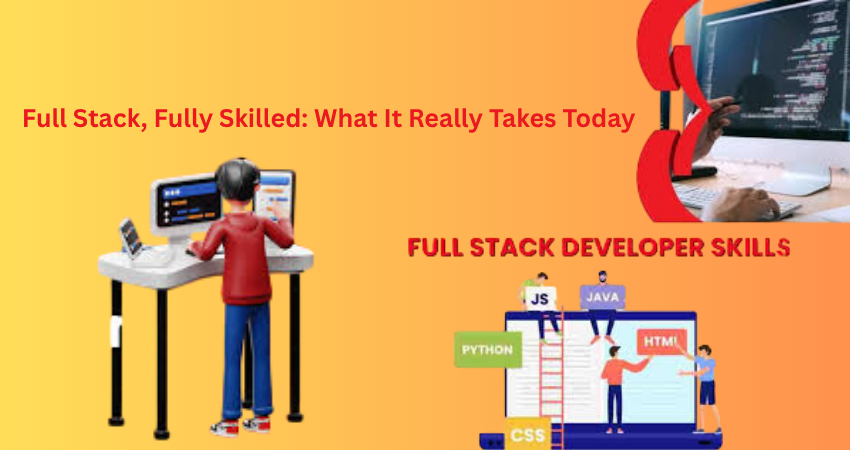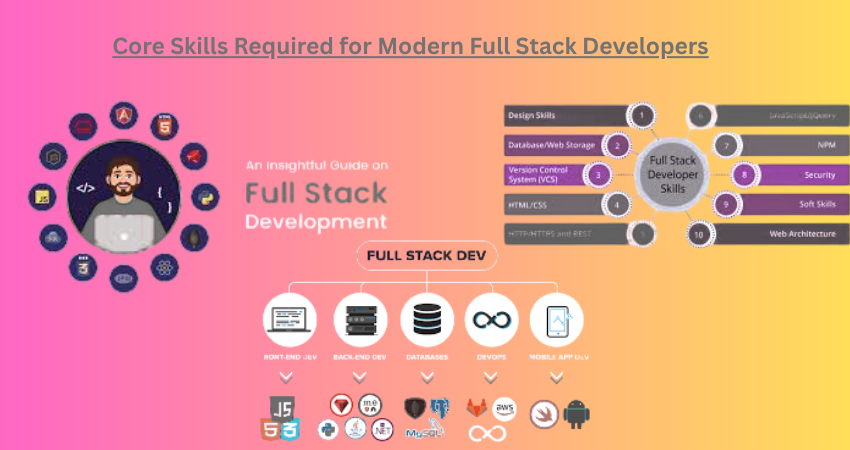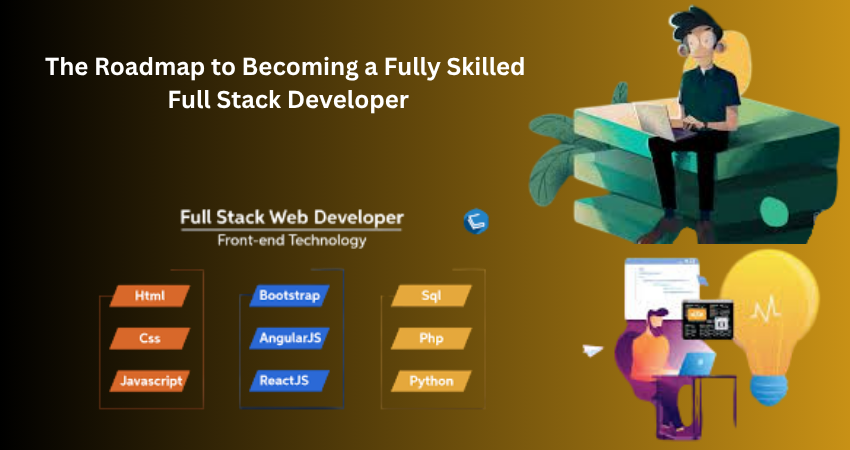
The Evolution of Full Stack Development
From Jack of All Trades to Master of Many
Back in the good old days, any developer who could code both front end and back end components of an application was branded a full stack developer. This usually meant knowing some HTML, CSS, JavaScript, and perhaps a back-end programming language like PHP or Python. Today, however, much has changed, and almost everything is a paradigm shift. Full stack developers have become expected to be competent in some web development, framework, deployment, DevOps, databases, cloud computing, CI/CD, and some aspect of UX/UI design. Therefore from a flexible generalist role, this job has transformed into one that demands breadth and depth in multiple highly technical disciplines.
These changes were not arbitrary; this transformation was incentive by insatiable demands of user requirements coupled with the concurrent growth of the ecosystems and plethora of technologically advanced platforms. Modern-day apps are now more complex than ever before with integrations to third-party APIs, real-time data handling, scalable solutions, and security best practices. Full stack developers are linchpins within agile teams, wherein fast development cycles and clear bottlenecks are concerned. With that role comes the huge pressure to remain updated in a fast-paced ecosystem. Gone are the days when being a “coder” sufficed; today, a full stack developer has to be an engineer, an architect, and sometimes a product strategist.
The Expanding Tech Stack
Almost all of today’s tech stack tends to go beyond the limited LAMP or MEAN stacks. Developers are expected to work with different front-end frameworks like React, Angular, or Vue; the back-end environment in place could be Node.js, Django, or Ruby on Rails; and for databases, they could go for SQL-based PostgreSQL or MySQL, or NoSQL ones like MongoDB or Firebase. And let us not forget about version control with Git, containerization with Docker, orchestration with Kubernetes, or setting up CI/CD pipelines with Jenkins or GitHub Actions; now that is just way too much!
A full stack developer is, therefore, someone who should not dabble in these areas. You ought to be at least generally proficient, if not deeply qualified, in the whole layer of development. This would require a mindset for learning and constant upgrading as technologies are changing faster than what most formal programs can keep up with. Nevertheless, specialization is a valid concept, but full stack becomes a way of life if you are flexible and resourceful-an extremely precious trait in a startup or lean engineering team. While a large stack skill set enables the developer to foresee problems earlier in the development cycle and offer end-to-end solutions with fewer handoffs, today, that ceaselessly remains one of the most coveted advantages in the rapidly shifting digital realm..
Core Skills Required for Modern Full Stack Developers

Frontend Mastery Beyond Pretty Interfaces
Front-end skills are often misconceived as being purely “window dressing.” On the contrary, front-end development is a very rigorous discipline involving performance optimization, accessibility, responsiveness, and usability in design. Such a developer ought to know how to architect a full-fledged robust single-page applications (SPAs) in React or Vue-know-how to manage the state efficiently using Redux, Zustand, or Pinia; and wrap it all up in super-interactive UI elements that do their magic without breaking speed or making usability compromises. Below HTML5, CSS3, and JavaScript lay the foundations; however, with virtual DOM, shadow DOM, progressive enhancement, and lazy loading, understanding these easy essentials is becoming more and more a part of the must-have.
The other component is accessibility (a11y), as well as the catchall standards of ARIA, that are used to ensure web applications usable by the disabled. Responsive design no longer is an option. It becomes part of the work to make sure the user experience stays consistent when users access applications on their 4K monitors or on mobile. Finally, they have to know how to use performance tools like Lighthouse or WebPageTest to diagnose and switch things up when they discover bottlenecks. With the full stack developer skill set, it means more than just making things pretty; it means making them run well, within everyone’s reach, and adapting smoothly to user contexts.
Backend Brilliance Powering the Engine Room
Backend on the stack implies all but data processing, logic, authentication, and integrations. A full-stack developer will need to know one or more back-end languages and frameworks. The languages and frameworks could be Node.js with Express, Python with Django or Flask, or Java with Spring Boot, but knowing some universal concepts such as MVC architecture, RESTful API design, and asynchronous processing is very important. Aside from the syntax, the actual backend development skill is the skill to code efficient, scalable, and secure backend logic that interacts seamlessly with databases as well as front-end clients. Security, scalability, and performance optimization are three key considerations that influence backend development.
It involves awareness of authentication frameworks like JWT or OAuth, rate limiting API call requests, input sanitization for avoiding any type of injection attacks, and employing a cache mechanism like Redis or Memcache. SQL and NoSQL databases become an absolute requirement, along with database schema design, indexing, and query optimization. Finally, most backends today operate on microservice architectures or serverless varieties involving Docker, Kubernetes, or cloud functions proficiency. A well-versed full stack developer isn’t merely writing endpoints—he/she is building systems that are solid, resilient, and production-ready scale. Soft Skills and Workflow Competencies
Soft Skills and Workflow Competencies
Communication and Collaboration in Agile Teams
Full stack not only encompasses the technical expertise, but also the soft skills that come along with it, well beyond their own definitions that are required. With agile setups, full-stacks also get immense chances of interaction with designers, project managers, QA engineers, and even the clients from time to time. This means they need to have good verbal and written communication skills. They ought to express thoughts concisely with estimations or blockers lifted during note-taking in a comprehending tone between departments. Additionally, it establishes connections between front and back-end development sides but must incorporate elements such as emotional intelligence, active hearing, and empathy.
They assist in user mood comprehension and matching various stakeholder expectations and cross-functional cooperation. A full stack developer operates using JIRA, Trello, or Notion, attends daily stand-ups/bike rides, sprint reviews, and retrospectives to fuel the team to its objective, and can truly bring value in the sense of making the team efficient and happy. In that manner, he is a full stack in today’s teamwork world: communication and feedback culture dynamic understands that a full stack exists in a team context. Version Control, CI/CD, and DevOps Fluency
Version Control, CI/CD and DevOps Fluency
Those days were behind us when one could code alone and then push it onto a server through FTP. Development cycles today are extremely automated, team-oriented, and integrated continuously. A full-stack developer is expected to possess expert-level knowledge of Git for version control, familiarity with branching strategies and also possessing the ability to fix merge conflicts without stalling progress. Apart from that, creating and managing CI/CD pipelines is also a part of the full-stack developer job. No matter it is Jenkins or GitHub Actions or GitLab CI or CircleCI, automating all builds, tests, and deployments is the demand of the new agile way of working. In addition, the DevOps wisdom is even becoming capacity for the complete stack DNA. Writing Dockerfile, container building, orchestrating services with Kubernetes, and even configuring cloud infrastructure with Terraform or Ansible are no longer specialty skills; they are now to be expected as standard.
This operationally sound insight enables full-stack developers to offer delivery of extremely-up-time code and accelerate the recovery process when things go wrong in production. The lines between development and operations are fading, and being suitably skilled is capable of navigating with confidence both sides. The Roadmap to Becoming a Fully Skilled Full Stack Developer Education, Projects, and Certifications While a computer science degree is not yet becoming obsolete by now, it is certainly opening avenues to becoming a full-fledged full stack developer.
The Roadmap to Becoming a Fully Skilled Full Stack Developer

Education, Projects and Certifications
This operationally sound insight enables full-stack developers to offer delivery of extremely-up-time code and accelerate the recovery process when things go wrong in production. The lines between development and operations are fading, and being suitably skilled is capable of navigating with confidence both sides. The Roadmap to Becoming a Fully Skilled Full Stack Developer Education, Projects, and Certifications While a computer science degree is not yet becoming obsolete by now, it is certainly opening avenues to becoming a full-fledged full stack developer.
Bootcamps, online certifications, or learning by self are potential entry options for a lot of others. What is truly important are skills and experience that can be demonstrated. For instance, experiencing working on actual projects, working on open sources, or having a personal portfolio website with a decent front end and solid back end can tell volumes much better than academic achievements.
Staying Ahead Learning in a Constantly Evolving Field
Dev stack developers may never keep pace with technological advancements. Thus, one may have to approach learning actively to ensure its currency. Reading industry blogs, subscribing to newsletters like JavaScript Weekly or DevOps Digest, and participating in developer communities like Stack Overflow, GitHub, or Reddit’s r/webdev are part of it. One may also watch YouTube video clips for tutorials and infuse insight into trends through various tech podcasts.
Keeping abreast with changelogs from primary instruments such as cutting-edge features of React or updates Node.js and how ECMAScript evolves is another pivotal aspect. The norm is that a developer should perceive learning life long and fast flexibility of skills because of new standards emerging. Today it may be React; tomorrow it may be Svelte or Solid JS. It’s really not that specific with these tools; it’s about being able to learn them quickly and apply them well. That’s what separates the coder from an up-to-date full stack developer.
Real World Challenges and How to Overcome Them
Balancing Breadth and Depth
Developers need a broad-spectrum of knowledge coupled with deep knowledge in all areas to be truly effective. It’s easy to get lost with a plethora of new tools and frameworks being constantly churned out in two areas that require more than average knowledge from a full stack developer front end framework after front end framework, back end language after back end language, and cloud, cloud, cloud, one can become so unfocused that one only has knowledge which does barely scratch the surface of real world problem solving. Concentrating too much on one area might also leave you incapable of addressing full-stack responsibilities, such as knowing how front-end performance could be hindered by a server failure or how state management on the client-side could determine the efficiency of an API.
Strategic specialization and cross-functional awareness are the answer. Begin with a solid grounding in core technologies-Javascript, HTML/CSS, one backend language, and Git; then gain proficiency in one front-end framework and one back-end stack. After that, keep on adding knowledge in supporting areas like testing, Devops, or, better still, cloud platforms. Don’t go after trends just because other people are doing it-track the needs of your project team, or where you can add the most value. The most important thing is not to be an expert in everything, but rather to know enough of many areas so that you can confidently build, deploy, and maintain full applications. This symbiotic approach will not only stack the cards in favor of you as an efficient developer but will also serve as an antidote to burnout from context-switching work constantly.
Coping with Burnout and Fast Paced Change
Even veteran developers at times find themselves being swept away by the overwhelming pace of technology. Fresh tools and new updates are released continuously, with some deeming it a compulsion to learn something new every day or be rendered obsolete. With the stampede of new technology, burnout strikes—emotional burnout and physical fatigue inducing lowered performance and decreased job satisfaction. Full stack developers are most vulnerable because it always has juggling of many responsibilities, sometimes staying updated in a multitude of domains, and solving high-stakes issues that cross the application lifecycle.
Burnout can be managed by taking on a sustainable rhythm of learning and working. Give real-world experience; rather than try to learn new things, spend a few areas deepening and building up those areas. Use spaced repetition, hands-on projects, and pair programming to reinforce learning in ways that don’t wear out the user. Everyone should make time for rest, personal hobbies, and life offline to recharge the mind. Most importantly, full stack developers should be fighting for a healthy work-life balance in their teams, shunning unnecessary overtime, and pursuing tools or workflows that maximize efficiency, not complicating the stack. In technology, as in other human endeavors, longevity has nothing to do with knowing everything-it’s the ability to be adaptable, resilient, and, above all, mentally, well equipped to evolve along with the industry.
Conclusion The Modern Full Stack Mindset
Today’s world of opportunities and challenges makes for a difficult journey becoming a fully skilled full stack developer. Basically, a full stack developer should know about coding; however, this is mostly the least requirement today. The real skills are problem-solving skills, communications skills, and a sense of ever-learning. A modern developer wears many hats: An engineer, an architect, a collaborator, and sometimes an educator.
Adaptability, breadth of knowledge, and depth of execution are the future of development. These three added together with one’s mindset, tools, and practices make one not just full stack but also future-proof.